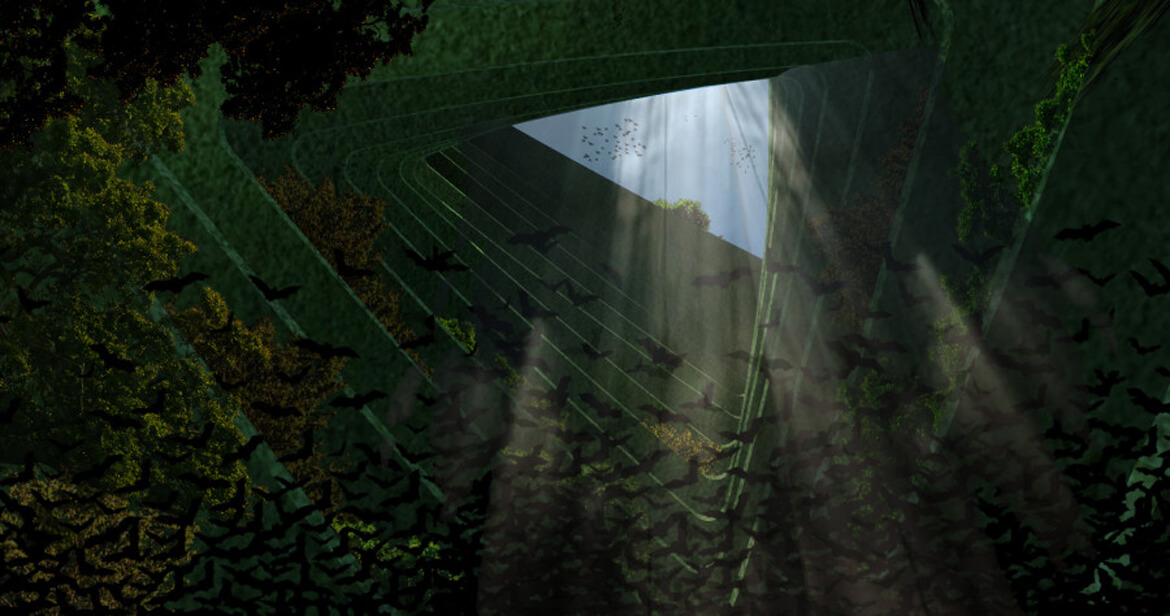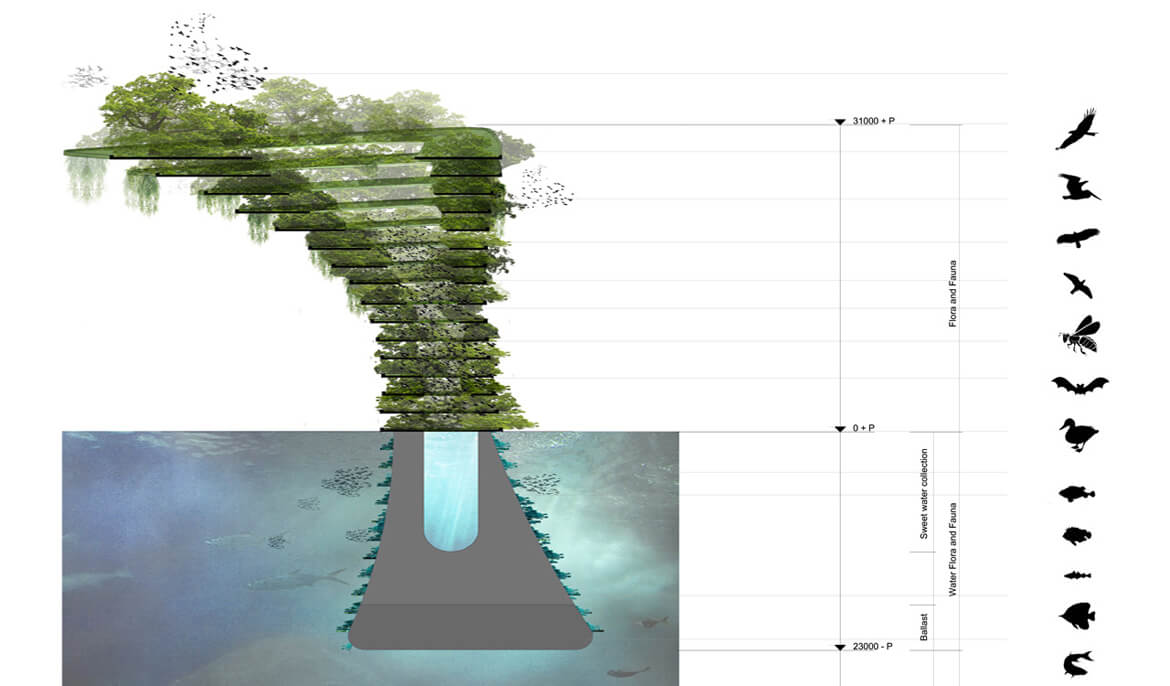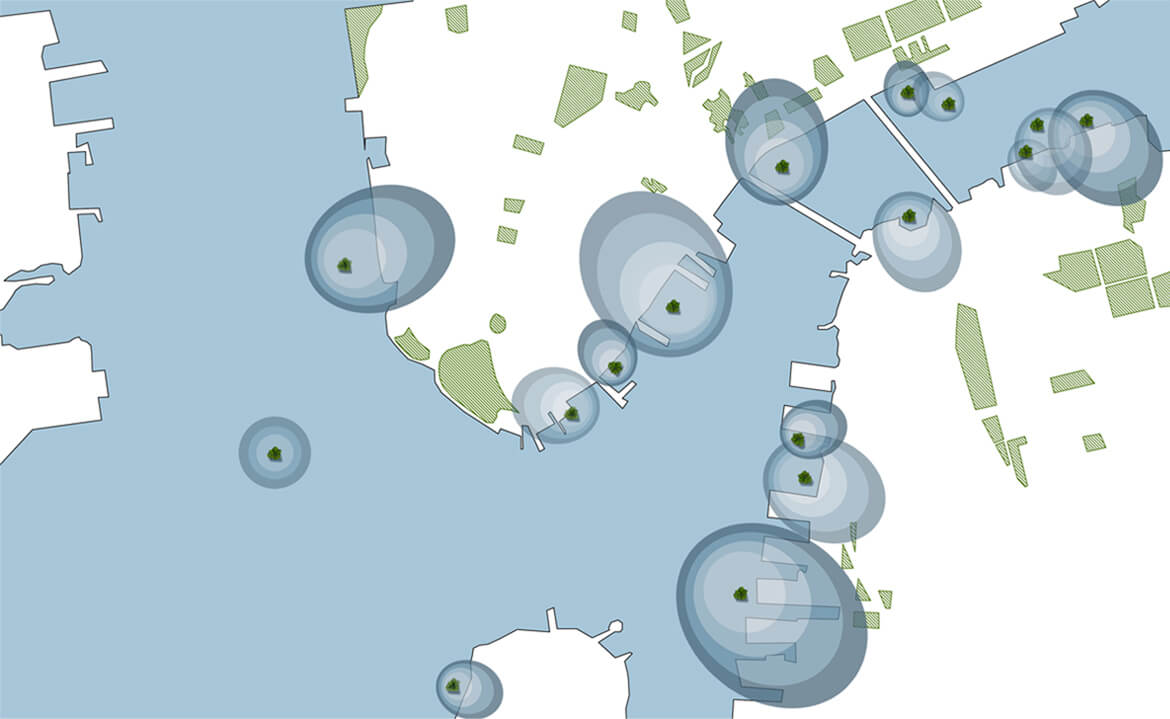Sea Tree at Cover
By Centre for the future of museums
Cover Trendwatch 2017
Photo Credits: Waterstudio
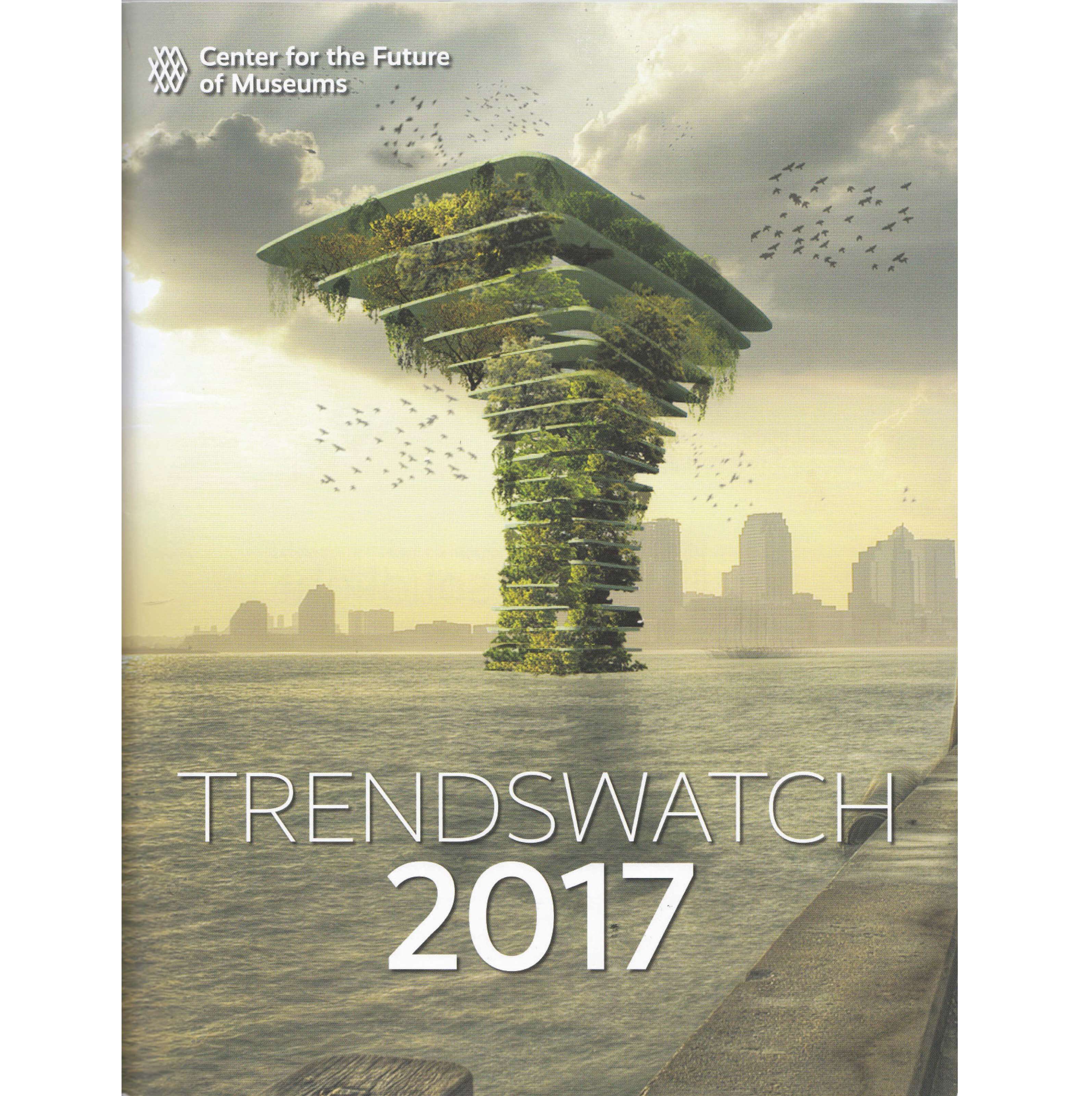
By Centre for the future of museums
Cover Trendwatch 2017
Photo Credits: Waterstudio

By Pierre-Mathieu Degruel
Cercle
2017
Photo Credits: Waterstudio
This prospective project created by the Waterstudio agency is designed to be located in harbours basins. This sea tree is a floating structure composed of superimposed immersed and emerged terraces. On each level a different ecosystem evolves and offers green habitats for animals rejected from citied (birds, bees, bats…). Under the sea’s surface, the tree recomposes an environment favourable to small marine creatures and, when the climate allows it, artificial coral reefs. A real modern day Noah’s Ark, this growth catalyser of fauns and flora is inaccessible to man. The cities of New York and Singapore are seriously considering installing some.
By Rachel Keeton
Next City
October.01.2014
Resilient Cities
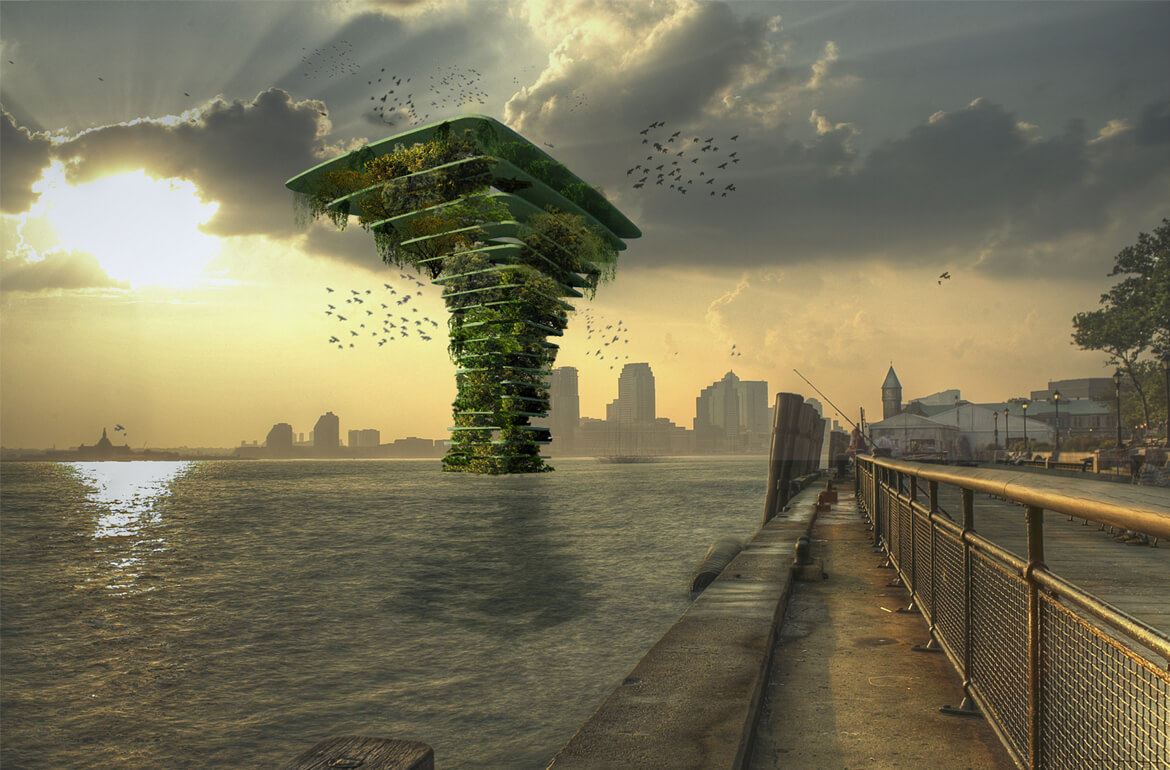
The Sea Tree, a floating natural habitat. (Photo by Waterstudio)
In a quiet, shady street in Rijswijk, the Netherlands, Koen Olthuis and the design team at Waterstudio are changing the world. From this deceptively nondescript headquarters, Waterstudio is designing the cities of the future. If Olthuis has his way, they will be safer, more flexible and more resilient than current cities. How will he do this? Olthuis is designing floating cities. As we sit down at the table, the busy office buzzing around us, my first question to Olthuis is direct: “How realistic are floating cities?” Olthuis grins and nods, he’s heard this question before.
Floating cities have captivated society’s imagination for centuries, from the development of Venice a millennium ago to Triton, designed for Tokyo Bay by Buckminster Fuller in the 1960s. But it wasn’t until the last decade or so that more fully realized, just-might-actually-happen sea-based urban endeavors have emerged, made more urgent by rising sea levels and rural-to-urban migration. In the last six months, Business Insider, Bloomberg and The Guardian have all run stories asking the same question: “Has the time come for floating cities?”
Olthuis dives right in: “It depends what you mean by ‘floating city.’ If you’re talking about a community of 100,000 in the middle of the sea, we’re probably about 50 years away from achieving that. If you want it to be completely self-supporting, it’s probably going to take another 20 years after that.” Bending over a roll of tracing paper, Olthuis quickly sketches a timeline of floating architecture. If we take it from the present moment, about midway on Olthuis’ sketch, hybrid cities are the next step in this evolution. Built on the edge of the existing city, these developments could easily connect to electrical and sanitation grids. “Technically, this stuff is easy to engineer: we’re already there,” says Olthuis. That makes them more straightforward to regulate and less risky for investors.
It’s the images of sparkling new cities lost at sea that have people raising skeptical eyebrows. “We’re working on a set of guidelines, a toolbox that will ultimately get us to the floating city you imagine. We’re working out these concepts that all give a glimpse of the future, but we have to find out what we need, how it works and what it adds to current urban development. We have to map out the steps to get us from today to the future and have to think about the entire process. And we need that, because if we don’t answer these questions, we get all these architects with beautiful renderings and fantastic ideas, but they don’t tell you the steps in-between and they don’t tell you why. And then your question is, but how realistic is it?”
Listening to Olthuis, it quickly becomes apparent that this scenario is actually incredibly realistic. With the technology and market demand in place, it’s political will and ownership issues that are holding development back. People have trouble imagining an urban future where city halls can be swapped for theaters on opening night, or entire Olympic villages can simply be towed around the world instead of rebuilt every four years. “Our cities today are too static. We make static cities for dynamic societies. We should be cities that can adapt to new demands and external influences. Water gives us three things: it adds more space (in old harbors, rivers, lakes), it’s safer (from storm conditions, rising sea levels) and it’s flexible. If you only construct the buildings you will use for 100 years statically, on land, and construct the buildings you will only use for 20 to 30 years flexibly, on water, then you’ve created a much more adaptable city that can respond to changing needs quickly and efficiently. If someone isn’t happy with their house anymore, they can ship it to someone who needs it in the Philippines.”
Governments are slowing starting to see the potential of this approach. If cities like New York or Tokyo build two to three percent of their development on the water, they can sell this to developers, tax the owners and create a more flexible city. Win-win. Governments are interested in this because it presents a new market for them. While most land is privately owned or already built up, by changing policies to make floating structures available the government expands its real estate. It’s a business model that is attractive because it solves multiple problems. Floating structures can reinvigorate former industrial areas like old harbors or riversides, they can adapt to extreme weather conditions better than traditional structures and they create a profit from space that is currently unmarketable.
Still, the idea of bobbing around permanently makes some people understandably squeamish. If one floating house goes up and down on waves, it may tilt: one half sits on the crest of a wave and the other end is stuck in the trough. This doesn’t happen when you start to build big enough to have a project that is always supported by multiple waves. On the water, the bigger the project, the more stable is it. In fact, floating cities are actually something that works better all around on a larger scale. If Olthuis is designing a watervilla for a single family, he has to calculate all kinds of factors to design a single, site-specific home. This ends up costing a lot more than a traditional house. If he’s designing a community of 10,000 water villas, the price is the same as a comparable urban development.
Moving functional amenities like prisons, stadiums and airports onto the water is already becoming more common as cities try to create more elbowroom for residents. Alvaro Siza’s recently completed chemical plant in Huai’An City, China, was built on the water, and BREAD Studio recently designed a floating cemetery to be rafted off the coast of Hong Kong – a city long on elderly citizens but short on space. Today there’s a floating skate park on Lake Tahoe and floating freshwater pools in the River Thames. There’s even a floating cinema in London by UP Projects, echoing Aldo Rossi’s iconic Il Teatro del Mundo from 1979.
Less whimsical but more crucial are floating developments for informal settlements located on waterfronts or in delta regions that are most vulnerable to rising sea levels. Kunlé Adeyemi’s floating school in Makoko, a picturesque shantytown in Lagos, Nigeria, will provide classroom space for 100 students. The problem with one-off projects like NLE’s floating school, according to Olthuis, is that the Lagos government has been against it from the beginning (it’s been declared illegal), and it’s not even being used because of this controversy. “If you want to really make a difference, it can’t be just one thing. It has to be a system with a sound business model,” says Olthuis.
“I think the current generation of architects really wants to help, they want to make a difference. If you tell the story of one billion people living in slums in places like Thailand, India, Bangladesh — where water is threatening those people and no one is helping them because anything that gets built can be wiped out by the next tsunami — we think, well we have to help those people. The City Apps project — retrofitted shipping containers floating on trash — is a system where we bring in floating schools, sanitation, electricity, water treatment facilities, bakeries, internet cafes, or whatever is most needed. We can connect these floating functions to the slums or disaster sites and they will slowly help upgrade these areas.
We’re investing in this ourselves, by funding the first prototype that will be deployed to Manila. We’ve started a foundation, working with Cordaid, where we lease the City Apps directly. It costs us about €50,000 to design and build a City App in a recycled shipping container, then it gets deployed to wherever it’s needed and there they construct a floating platform out of old plastic bottles and other rubbish. Ultimately, it should be a business model that provides an entrepreneurial opportunity for residents of these areas. It’s cheap — they just pay a small monthly fee — it’s safe, since it goes up and down with the water, and it provides a solution to real problems. If you don’t need it anymore, you just send it back to us and we lease it out to someone else. Next year we’ll have ten, the year after, a hundred, and it will grow to a few thousand containers around the world. Of course, it’s just a small help to these millions of people, but we hope it will act as a model and show that we can shift from giving aid to providing an opportunity for employment.”
On the other end of the inclusiveness spectrum, there are politically motivated projects like the Seasteading Institute’s Floating City. Promoted with viral videos and backed by private donors and crowd funding, these mobile communities are envisioned as new experiments in governance, giving each community total political autonomy over itself. After attending the third Seasteading Institute conference in 2012, Josh Harkinson of Mother Jones summarized the Institute as “a hacker’s approach to government with a Waterworld-esque conception of Manifest Destiny. More than a mere repository for political dreamers, it brings together engineers, scientists, and entrepreneurs of the sort one often finds in the Bay Area: techtopians who might be brilliant or delusional — or both.”
Olthuis accepts that different floating communities may have different goals. “I think we’ve only seen about 10 percent of the ideas that are actually possible in terms of floating architecture. In the next century, we’ll have thousands and thousands of new architects who can think about these possibilities.” Waterstudio calls their floating designs “scarless,” meaning they can be repositioned without leaving any trace of their presence. But the next step is to build designs like the Sea Tree, a floating natural habitat that would give small fish a sanctuary, increase the oxygenation of water, and potentially collect trash as it drifted about.
Olthuis is adamant that we have to embrace the water rather than run from it — we don’t have any other options. “Today, the momentum is there because we see the effects of climate change and we can’t be sure about our safety. We see millions of people moving to the cities and we don’t know where they will live. These issues are finally making people think twice about floating architecture. If we can convince them that it’s also financially profitable and help governments change building regulations, we’ll have a future where it’s normal to see cities that are 95 percent built on land and five percent built on water — just enough to give them the flexibility they need for an uncertain future.” It’s a revolutionary way of thinking about the city: puzzle pieces that can be reconfigured according to changing needs and desires. Olthuis’ concern with marketability and political interest makes his story much more convincing than the glossy renderings popping up on design websites. “Many architects are using technical solutions to approach this problem and just showing us the images without any information. I think a floating city is only something that works when it makes sense economically, socially, spatially — and should also look nice. It should be a normal development that is open to everyone, rather than an alien form for an elite few.” His belief in the advantages of these projects is clear, and the built examples in the Maldives, China and the Netherlands are proof of their viability. Just as it was for Buckminster Fuller 50 years ago, the floating city remains an exciting and mysterious model of urban development. Only now, it’s closer than ever. And Koen Olthuis can tell you exactly how to build it.
By Tailor Hill
Takepart
August.2015
The offshore structures would provide habitat for animals, birds, and fish.

Taylor Hill is an associate editor at TakePart covering environment and wildlife.
In the world’s biggest cities, it’s hard enough for humans to find a little elbow room—now think about carving out habitat for wildlife in places like Manhattan.
Dutch architect Koen Olthuis thinks he has the design that can extend urban sprawl into city waterways—but instead of floating high-rises offshore, he envisions wildlife oases within city limits.
Called Sea Trees, the steel structures are based on existing offshore oil platforms. Anchored to the ocean or river floor, Sea Tree pillars would extend above and below the water surface, providing “layered” habitats—almost like the floors of a skyscraper—for flora and fauna.
“Oil companies have used these floating storage towers for years, we only gave them a new shape and function,” Olthuis said in a statement.
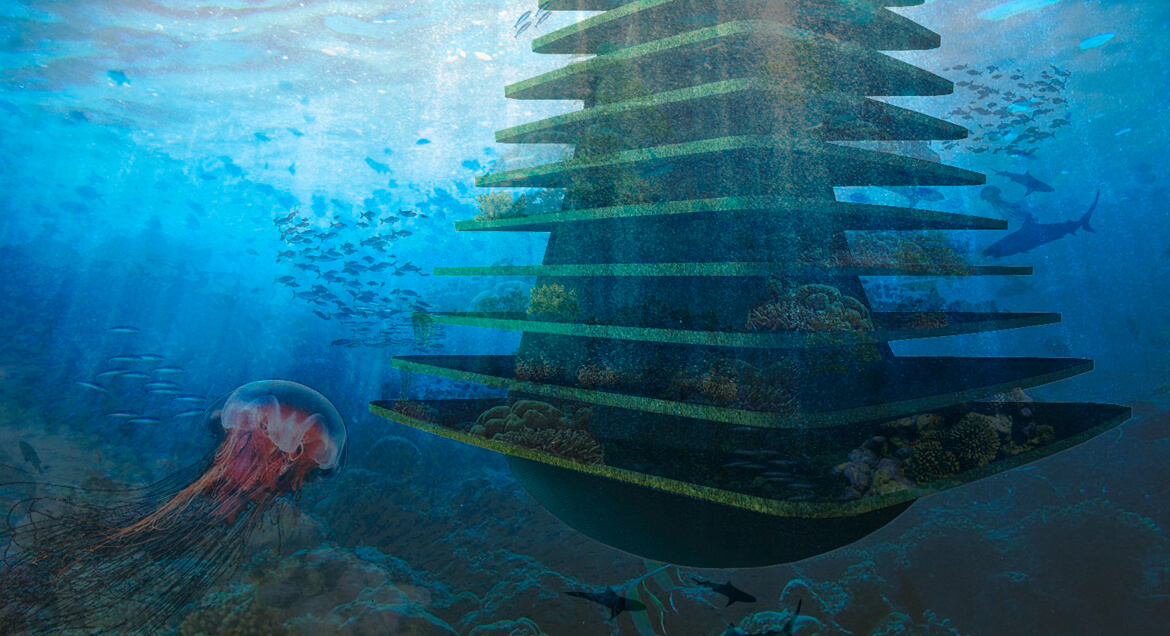
Olthuis, head architect at Waterstudio, thinks Sea Trees could bring animals back to areas taken over by humans, helping to stem falling wildlife populations.
“It is becoming evermore difficult to allot an appropriate amount of land for the conservation of wildlife habitats within city limits,” said Olthuis. “Sea Tree would provide the ideal environment for a multitude of species, not to mention a significant reduction in CO2 emissions.”
Rivers, oceans, lakes, and harbors could all be potential locations for Sea Trees, giving a home to birds, bats, and bees above the waterline while providing habitat for fish, crustaceans, and even coral reefs below the surface.
Waterstudio imagines a forest of Sea Trees built off the Manhattan and Brooklyn waterfront; it could provide living spaces for wildlife along some of the most expensive stretches of real estate in the United States.
Olthuis designed Sea Trees to be inaccessible to humans.
“Water is, of course, a perfect way to keep people away,” Olthuis said. “In the end, it has become a vertical hangout for wildlife.”
While the concept is still in the development phase, Waterstudio thinks Sea Trees could be built today because much of the technology exists. The architecture firm estimates each Sea Tree would cost about $1.2 million, depending on the water depth and construction materials used.
“Large oil companies will have the opportunity to give back by using their own intellectual property and resources to donate Sea Trees to a community in need, showing their concern and interest in preserving the distressed wildlife,” Olthuis said.
By Ana Swanson
The Washington Post
December.2014

In many of the world’s fast-growing cities, there isn’t enough room for people to live, let alone wildlife. Our friends beneath us in the food chain are becoming increasingly marginalized—world wildlife populations have decreased by about half over the last 40 years alone. Now, there’s a plan to give urban homes back to wildlife. But these homes aren’t quite urban. They’re, essentially, giant floating trees.
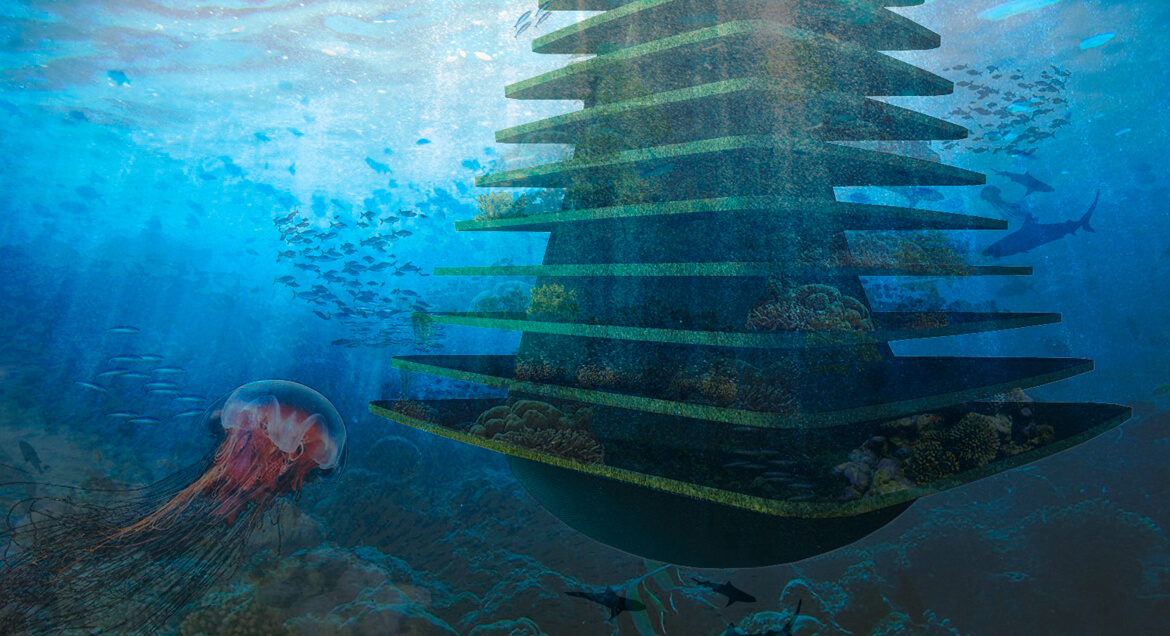
The underwater portion of a “Sea Tree.” (Waterstudio)
Waterstudio, a Dutch architectural firm that specializes in designing floating structures, wants to erect “Sea Trees” in major cities. The structures are multi-tiered, tree-shaped habitats that float near urban areas and could provide sanctuary for birds, bees, bats and small aquatic creatures that might not be cut out for city living in the 21st century.
Based on the technology in oil storage towers, the trees have multiple platforms for accommodating wildlife. The underwater portion can house fish and other sea creatures and even provide an artificial coral reef in climates that will allow it.
Koen Olthius, Waterstudio’s founder, told Fast Company that the concept is ready to be implemented as soon as possible. “Our favorite locations would be Mumbai or New York,” he said. “Both have such a high price on land that it makes the construction of new park zones on land not feasible.”
According to Waterstudio, the design would cost approximately 1 million euros ($1.23 million) to build. The idea, of course, may never actually come to fruition, but it looks like a clever and innovative way for cities to give refuge to animals that badly need it
By Giulia Mattioli
La Stampa
October.2014
Sea Tree. Un progetto innovativo per preservare la flora e la fauna selvatiche sfruttando le grandi aree marine e lacustri
Navigare sul sito web di Waterstudioè un notevole viaggio della mente: i loro progetti architettonici, alcuni davvero visionari, si legano indissolubilmente all’elemento acquatico. Case galleggianti, palazzi sottomarini, strutture che funzionano dentro e fuori dall’acqua: se lo scenario del film ‘Waterworld’ si realizzasse veramente, loro saprebbero come adattarvisi. Il confine tra terra e mareper Waterstudio non è un limite, ma una nuova frontiera da esplorare, anche in coscienza del cambiamento climatico e dell’espansione degli agglomerati urbani.
Tra i progetti più audaci e affascinanti dello studio di architettura olandese c’è Sea Tree®, una sorta di palazzo galleggiante che svetta sull’acqua, adibito a giardino dove trovano ospitalità diverse specie animali. Non è un progetto per gli umani, ma per la flora e la fauna costantemente minacciati dall’espansione urbanistica, i cui habitat vengono ristretti e alterati di anno in anno in favore delle necessità della modernizzazione. Conservare la fauna selvatica di ogni territorio è fondamentale, ma l’espansione delle città non ne tiene particolarmente conto, ed ecco che i laghi, i fiumi, i mari potrebbero diventare il luogo dove preservare uccelli, insetti, pipistrelli e piccoli mammiferi.
Sea Tree è un grattacielo di biodiversità, che si può collocare benissimo accanto ad un’area urbana, ma nei suoi bacini idrici, in modo da rimanere isolato e protetto dall’avanzata del cemento. Si tratta di una struttura in acciaio, galleggiante, composta di strati di vegetazione, giardini verticali che provvedono alla sussistenza delle specie animali, che includono dei piani sommersi per piccole creaturine acquatiche e, se la latitudine lo permette, per barriere coralline artificiali, habitat a loro volta per centinaia di esseri viventi. Naturalmente in base alla posizione, alla profondità delle acque, alle mareggiate, alle correnti, alle temperature ogni Sea Tree avrebbe altezze e caratteristiche differenti.
Dal punto di vista della tecnica, Sea Tree si basa su una progettazione molto simile a quella delle piattaforme petrolifere offshore, e proprio alle grandi compagnie si rivolgono i membri di Waterstudio per caldeggiare la realizzazione di un ‘condominio’ marittimo per animali. Oltre alle loro torri di stoccaggio e le loro piattaforme, perché non donare alla natura e alla comunità un Sea Tree, fosse anche solo per dimostrare un po’ di buona volontà nel rendere il mondo che tanto sfruttano un posto migliore? Un progetto forse visionario ma assolutamente innovativo per far luce sulla necessità di proteggere la flora e la fauna selvatica di ogni angolo del Pianeta dove vi sia sufficiente acqua per realizzarlo. E considerata la grande esperienza che ingegneri, architetti, tecnici olandesi hanno nel confrontarsi con l’acqua e con i territori dove terra e mare si fondono, a cui si aggiunge il fatto che le torri per lo stoccaggio del petrolio in mare già esistono, i progettisti di Sea Tree hanno ‘semplicemente’ adattato, modificato le tecnologie già esistenti per fare un favore alla natura.


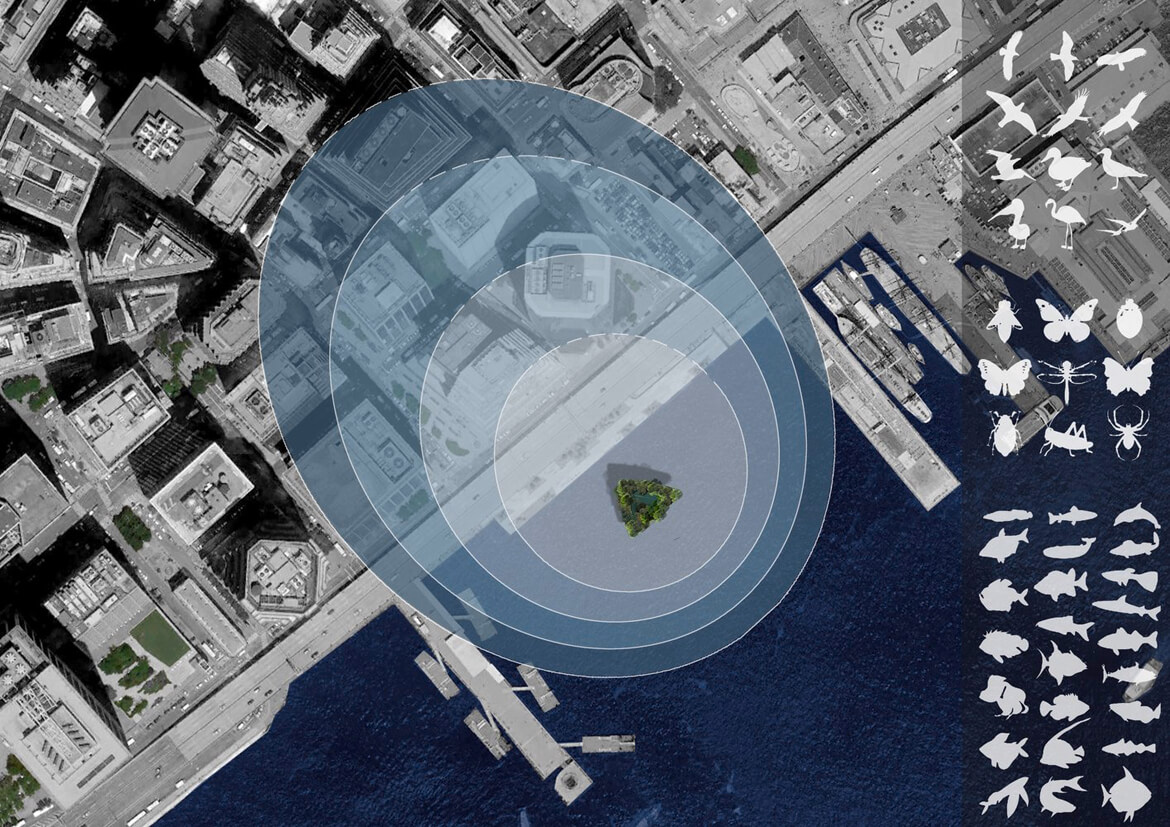
By Katherine Brooks
Huffington Post
September.18.2014
“The waterfront no longer places a limitation on city expansion, in fact it is the new frontier!”
So begins the description for “Sea Tree,” a futuristic nature reserve imagined by Netherlands-based architecture firm, Waterstudio. The wild design, still in the rendering phase, would bring floating steel structures to the shores of urban centers. And inside those steel towers, would be vegetated layers of habitable space, meant for both flora and fauna to flourish in spaces where land and wildlife is scarce.
 According to Waterstudio, Sea Tree would be built using the “latest offshore technology,” similar to that used in building oil storage towers in the open ocean. But instead of housing oil, the towers would play home to plant and animal species, working to reduce CO2 emissions along the way.
According to Waterstudio, Sea Tree would be built using the “latest offshore technology,” similar to that used in building oil storage towers in the open ocean. But instead of housing oil, the towers would play home to plant and animal species, working to reduce CO2 emissions along the way.
“Large oil companies will have the opportunity to give back by using their own intellectual property and resources to donate Sea Trees to a community in need,” Waterstudio wrote in a statement to HuffPost, “showing their concern and interest in preserving the distressed wildlife.” It’s a utopian endeavor, sure, but it offers already over-populated metropolises a chance to conserve wildlife within city limits.
The design, inspired by a project in Holland in which ecologists asked the firm to design a green oasis that could not be disturbed by humans, is meant for any waterfront, from riverbanks to sea shores. The height and depth of the structures would be custom constructed according to their specific locations, and would be anchored to the seabed with cables. The birds, bees, bats, and other small animals seeking refuge on a Sea Tree would be left untouched by humans, as would the plant life.
“Most of the innovation on land has been done already,” Koen Olthuis, Waterstudio lead designer and co-founder, explained to The Creator’s Project. “The truly innovative possibilities are found on water… The idea is that we cover the tower with fertile soil and then simply take our hands off of it and let nature do its thing. That’s the exciting part: to see what kind of effect such a green enclave will have.”
When asked when we could expect Sea Tree to become a reality, Ankie Stam at Waterstudio responded to HuffPost: “We’re now in the process of [finalizing] location (with city councils) and finance (with oil companies), for which we have several options. When this is completed we can start construction.”
Waterstudio sent us a selection of images that show the possibilities of Sea Tree. Let us know your thoughts in the comments. And for other floating architectural feats, check out Cristian Ehrmantraut’s prototype for a floating platform that filters the ocean and absorbs plastic.

